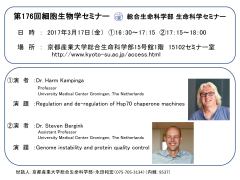総合生命科学部 生命科学セミナー開催(3月17日)
2017.03.02
第176回細胞生物学セミナー/総合生命科学部 生命科学セミナー
| 日時 | 2017年3月17日(金)【第1部】16:30~17:15 【第2部】17:15~18:00 (16:15開場) |
|---|---|
| 場所 | 京都産業大学 15号館1階15102セミナー室 |
| 交通 | ※キャンパス内に駐車場はありません。公共交通機関をご利用ください。 交通アクセス |
| 備考 | 事前申込不要・入場無料 |
第1部:Dr. Harm Kampinga(University Medical Center Groningen)
「Regulation and de-regulation of Hsp70 chaperone machines」
The appropriate folding of proteins, their transport and assembly into functional complexes, and their timely breakdown are crucial to maintain cellular functionality. A crowded cellular environment requires these processes to be guided by molecular chaperones. Hsp70, is a central chaperone in the Protein Quality Control (PQC) network. Hsp70 is central to nearly all PQC activities in cells. How Hsp70 can execute all these cell biological functions in a coordinated manner, and how it can be directed to specific targets and instructed to execute these functions in different cell types is still largely unknown. We propose and show that Hsp70 co-factors are key to regulating Hsp70 function and determine client input (DNAJ, small HSP) and output (NEFs). We show how manipulations of these regulators can be used to steer Hsp70 machines to perform certain functions, e.g. to prevent or cure a range of protein aggregation diseases. Inversely, it will be shown how mutations in some Hsp70 co-regulator can lead to protein-aggregation diseases in neuronal and (cardio)muscular tissues (so-called chaperonopathies).
第2部:Dr. Steven Bergink(University Medical Center Groningen)
「Genome instability and protein quality control」
It has been well documented that DNA repair deficiency not only predisposes for cancer, but also leads to neuropathology. Why compromised DNA repair leads to neuropathology has remained unclear. For example, the neurodegenerative disease Ataxia Telangiectasia (AT) is caused by the loss of ATM (AT mutated), a kinase with a central role in DNA damage signaling.
We show that in ATM knock out cells aggregated proteins accumulate. A similar accumulation is seen in brains from atm mutant flies. These results imply the development of an imbalance in protein homeostasis. An imbalance in protein homeostasis is often a hallmark in many other heritable neurodegenerative diseases that are caused by protein-destabilizing, toxic gain of function mutations, like in polyglutamine diseases (e.g. Huntington’s disease or Spinocerebellar Ataxias (SCA)). Interestingly, the degenerative phenotype of SCA3 flies was significantly enhanced in an ATM-compromised background. Moreover, in ATM knock out cells polyglutamine containing polypeptides aggregation is increased. Finally, we observe the accumulation of insoluble polyubiquitylated material in atm knock out material. Intriguingly, a similar increase in insoluble-ubiquitin levels in the brains of irradiated flies more than a week after DNA damage induction, is observed. Indeed DNA damage induction by gamma irradiation of Drosophila larvae causes dramatic neuropathology, leading to functional locomotor deficits in the adult.
In a dedicated screen, we identified chaperones that are capable of suppressing the genome instability driven protein aggregation. Intriguingly when we overexpress the homologues of these chaperones in fly brains we can revert the DNA damage-induced reduced life span almost back to the life span of non-irradiated flies. Importantly the over expression of these chaperones doesn’t influence DNA repair.
These data imply that DNA damage leads to neuropathology via an imbalance in protein homeostasis. DNA damage will become fixed into genomic alterations, giving rise to the expression of metastable polypeptides that, in turn, cause a collapse in the protein homeostasis, thereby initiating neurodegeneration.
We show that in ATM knock out cells aggregated proteins accumulate. A similar accumulation is seen in brains from atm mutant flies. These results imply the development of an imbalance in protein homeostasis. An imbalance in protein homeostasis is often a hallmark in many other heritable neurodegenerative diseases that are caused by protein-destabilizing, toxic gain of function mutations, like in polyglutamine diseases (e.g. Huntington’s disease or Spinocerebellar Ataxias (SCA)). Interestingly, the degenerative phenotype of SCA3 flies was significantly enhanced in an ATM-compromised background. Moreover, in ATM knock out cells polyglutamine containing polypeptides aggregation is increased. Finally, we observe the accumulation of insoluble polyubiquitylated material in atm knock out material. Intriguingly, a similar increase in insoluble-ubiquitin levels in the brains of irradiated flies more than a week after DNA damage induction, is observed. Indeed DNA damage induction by gamma irradiation of Drosophila larvae causes dramatic neuropathology, leading to functional locomotor deficits in the adult.
In a dedicated screen, we identified chaperones that are capable of suppressing the genome instability driven protein aggregation. Intriguingly when we overexpress the homologues of these chaperones in fly brains we can revert the DNA damage-induced reduced life span almost back to the life span of non-irradiated flies. Importantly the over expression of these chaperones doesn’t influence DNA repair.
These data imply that DNA damage leads to neuropathology via an imbalance in protein homeostasis. DNA damage will become fixed into genomic alterations, giving rise to the expression of metastable polypeptides that, in turn, cause a collapse in the protein homeostasis, thereby initiating neurodegeneration.

